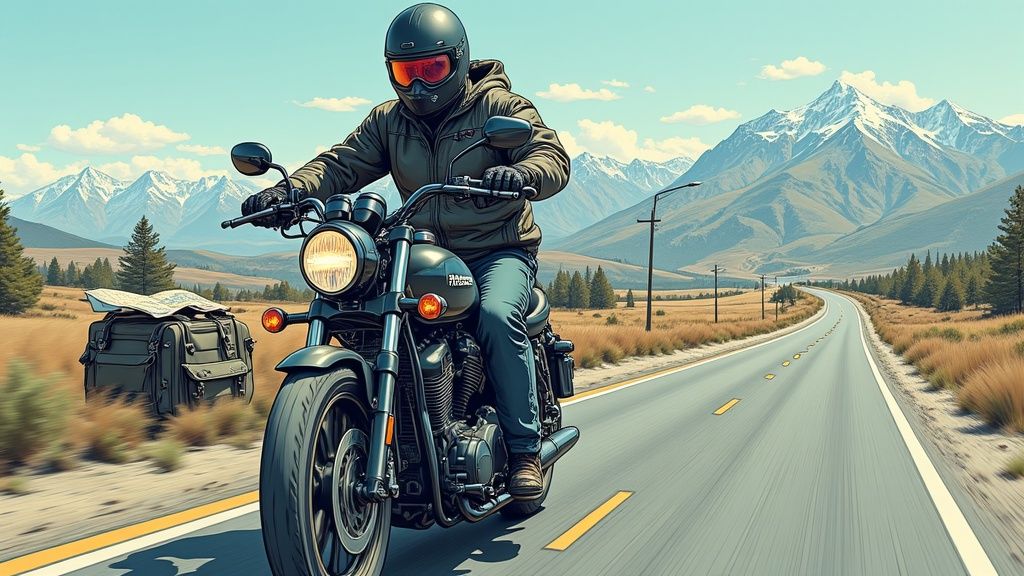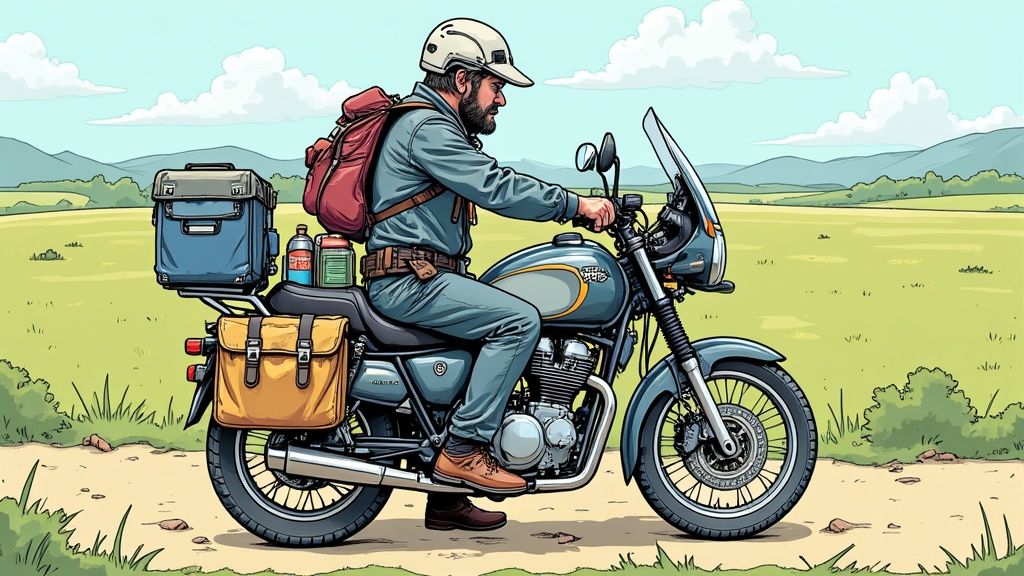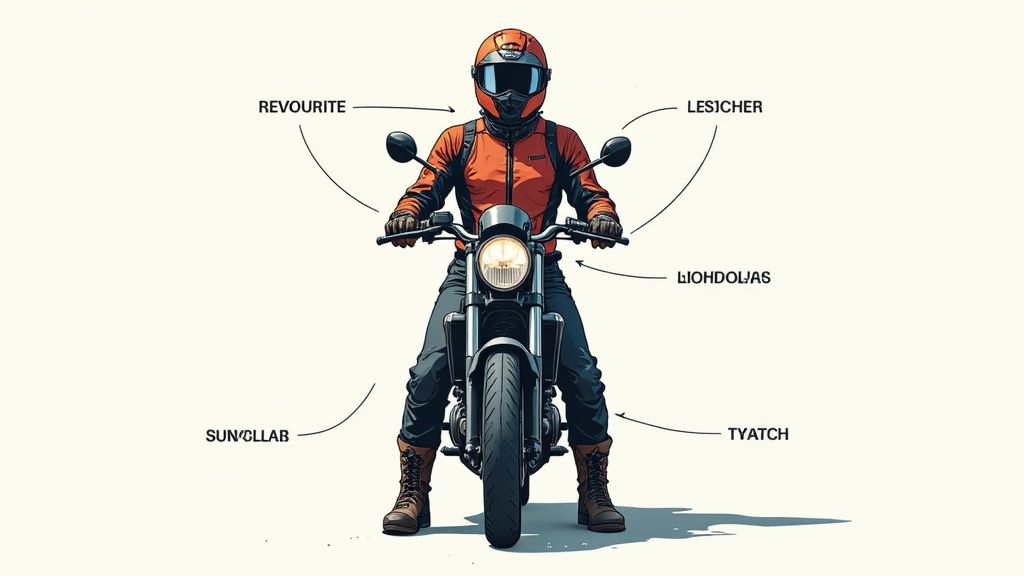
Long Distance Motorcycle Riding Tips: Your Complete Guide to Safe and Successful Adventures
Understanding the Real Risks (And How to Handle Them)

Taking your motorcycle on long trips brings an incredible sense of freedom - but it’s critical to understand and prepare for the real safety challenges involved. The data tells a sobering story: in 2022, motorcyclists faced a fatality rate of 26.16 per 100 million vehicle miles traveled. Being aware of these risks and taking concrete steps to address them can make the difference between a memorable adventure and a dangerous situation.
Recognizing the Statistical Realities
The numbers paint a clear picture about motorcycle safety that every rider should know. Motorcyclists make up a disproportionately high percentage of traffic deaths compared to other vehicles, mainly because bikes offer less protection in crashes and leave riders more exposed to road hazards and weather. Many accidents also involve riders without proper licenses, which shows why proper training and following traffic laws matter so much. This means preparing for a long trip requires more than just packing gear - it demands understanding these risks and committing to safe riding practices.
The Power of Protective Gear
One of the most important ways to stay safe is using the right protective equipment. Helmets play a crucial role in preventing deaths - while laws vary between states, wearing one consistently is a proven way to reduce risk. Quality jackets, gloves, and boots also provide vital protection if things go wrong. Bright, reflective clothing helps other drivers see you better, especially in low light. Just as a ship needs a strong hull to handle rough seas, riders need reliable gear to handle the hazards of the open road.
Strategic Riding Habits for Enhanced Safety
Smart riding habits go hand in hand with good gear for staying safe on long trips. Planning routes carefully, taking regular breaks, and adjusting your riding style for different conditions all help reduce risk. When possible, avoid peak traffic hours and bad weather. Since many motorcycle crashes happen on busy city streets, choosing less congested highways often makes sense. And with almost half of motorcycle deaths occurring on weekends, staying alert every day of the week is essential. These habits act like an experienced guide, helping you make safer choices and spot potential problems early.
Maintenance and the Long Haul
Regular motorcycle maintenance is essential for long-distance riding success. Checking key parts like tires, brakes and lights helps prevent breakdowns and keeps your bike running well. Carrying basic tools and knowing how to make simple repairs can save you if problems come up on the road. Like a runner wouldn’t start a marathon without proper training, a motorcycle needs to be mechanically sound before a long journey. Following these maintenance practices helps turn potentially risky trips into well-planned adventures with the best chances of going smoothly and safely.
Essential Gear That Actually Makes a Difference

When it comes to long-distance motorcycle riding, having the right gear isn’t just about checking boxes - it’s about creating a complete system that keeps you safe and comfortable mile after mile. The equipment you choose plays a vital role in both protecting you and helping you stay focused on the road ahead.
The Foundation: Safety and Protective Gear
Your safety gear starts with a properly fitted helmet that meets current safety standards. This single piece of equipment is critical, as motorcycle riders face much higher risks on the road compared to car drivers. Quality riding jackets, pants, gloves, and boots are also must-haves. Look for gear with reinforced areas and built-in armor - these features can mean the difference between minor scrapes and serious injuries if you end up sliding across pavement.
Enhancing Comfort for the Long Haul
Long rides demand serious attention to comfort. A basic stock seat often isn’t enough for extended time in the saddle. Consider upgrading to a sheepskin cover, air cushion, or custom-fitted seat to prevent soreness and fatigue. For example, a good aftermarket seat can help distribute pressure more evenly and keep you riding comfortably for hours.
Your riding position also makes a huge difference in comfort. Small changes to your handlebars and foot pegs can dramatically improve ergonomics. Bar risers help maintain better posture by letting you sit more upright, which reduces strain on your wrists and shoulders. Similarly, adjustable foot pegs let you find the perfect position for your height and riding style.
Weather Protection: Adapting to Changing Conditions
Weather can change quickly when covering long distances, so being prepared is essential. A good layering system with waterproof and windproof outer layers helps you handle whatever conditions you encounter. Pack versatile pieces that work together - for instance, a breathable base layer under a waterproof jacket gives you options as temperatures change. Don’t forget specialized gear like heated clothing for cold weather or mesh gear for hot days.
Communication and Navigation: Staying Connected
Safe long-distance riding requires reliable navigation and communication tools. A Bluetooth helmet system lets you hear directions, take calls, and communicate with other riders without taking your hands off the bars. Mount your phone or GPS unit where you can easily see it while keeping your focus on the road. Good navigation tools help you stay on route and find fuel stops, especially in unfamiliar areas. This combination of communication and navigation gear helps create a safer, more enjoyable ride while letting you concentrate on what matters most - the road ahead.
Strategic Route Planning for Success

While having quality gear and maintaining your motorcycle are essential, poor route planning can quickly turn an exciting journey into a challenging ordeal. Smart route planning helps create an enjoyable and safe experience. This involves careful consideration of various factors beyond just marking start and end points on a map.
Mastering the Art of Route Selection
Choosing the right roads begins with an honest assessment of your riding abilities and preferences. New riders often do better avoiding busy highways, while experienced motorcyclists might seek out twisting mountain passes. Consider practical aspects like road surface quality, traffic patterns, and potential hazards. Take time to identify motorcycle-friendly stops - from scenic viewpoints to restaurants and campgrounds that welcome riders. This advance research lets you focus on enjoying the ride instead of constantly searching for basic necessities.
Weather Wisdom for the Open Road
Understanding weather patterns is crucial for long-distance riding success. Beyond checking the basic forecast, learn to read weather maps and recognize how geography affects conditions. Mountain ranges can create dramatically different weather on each side, while valleys may funnel strong winds. Popular weather apps and radar maps are valuable tools for staying informed. Always have alternate routes ready in case conditions force a change in plans. Being prepared helps you avoid dangerous situations while staying safe and comfortable.
Creating a Flexible Itinerary
A tight schedule can rob the joy from any motorcycle journey. Instead, build flexibility into your daily plans to allow for unexpected discoveries and delays. Add buffer time each day for traffic, road work, or exploring interesting stops along the way. This relaxed approach transforms your ride from a rushed timeline into an engaging adventure where you can truly appreciate each moment and location.
Urban vs. Rural Riding Strategies
Different environments require different riding approaches. Cities present challenges like dense traffic, pedestrian activity, and frequent stops - factors that contributed to 66% of motorcyclist fatalities occurring on urban roads in 2021. Rural areas offer open spaces but fewer services, making fuel planning and constant awareness essential. By adjusting your riding strategy to match the setting, you can better handle the unique aspects of each environment.
Smart route planning significantly improves both the safety and enjoyment of long-distance motorcycle rides. When you treat route planning as a key part of trip preparation rather than an afterthought, you create the foundation for a truly memorable journey on the open road.
Motorcycle Maintenance Secrets for Distance

While planning smart routes is essential for long motorcycle trips, keeping your bike in top condition is equally important. Regular maintenance isn’t just about preventing breakdowns - it provides peace of mind and ensures your safety mile after mile. Understanding key maintenance tasks and performing them correctly makes all the difference.
Pre-Trip Inspection: A Rider’s Checklist
A thorough inspection before any major ride can prevent problems down the road. This means methodically checking critical components that directly impact your safety and bike performance:
-
Tires: Monitor pressure and check tread depth carefully. The right tire pressure gives you better handling and fuel economy. Watch for damage or uneven wear patterns.
-
Brakes: Look at brake pad thickness and check fluid levels. Your brakes need to work perfectly, especially on long downhills or sudden stops.
-
Lights: Test every light - headlight, tail light, turn signals, and brake lights. Good lighting keeps you visible to others, particularly at night or in bad weather.
-
Fluids: Check oil, coolant and clutch fluid. Running low on any of these can lead to overheating or mechanical issues.
-
Chain/Belt: Make sure your drive chain or belt has proper tension and lubrication. A poorly maintained chain can cause serious trouble on long rides.
Following this checklist helps ensure your bike is truly ready for distance riding. But don’t stop there - ongoing maintenance during your trip is just as vital.
On-The-Road Maintenance: Staying Proactive
Long trips demand regular attention to your bike’s condition. Small issues can become big problems if ignored. For example, tire pressure often changes with temperature and altitude differences, affecting how your bike handles. Checking pressure regularly and adjusting as needed helps maintain optimal performance. Having basic tools on hand also lets you fix minor problems yourself.
Pack a compact kit with wrenches, screwdrivers, Allen keys, tire repair supplies and zip ties. Simple things like tightening loose bolts or fixing electrical gremlins become manageable instead of trip-ending ordeals.
Troubleshooting Common Issues
Even well-maintained bikes can develop problems. Learning to spot and fix common issues helps you handle challenges confidently. If your engine starts sputtering, you might have fuel delivery problems. Basic knowledge of how to inspect fuel lines, filters and spark plugs helps diagnose the cause and find solutions. Understanding motorcycle basics turns you from passenger to problem-solver, giving you more control over your journey. Tools like Auto Service Logger help track maintenance history and service intervals, making it easier to spot patterns and prevent recurring issues on long rides.
Making these maintenance practices part of your routine improves both safety and enjoyment on long motorcycle trips. A properly maintained bike becomes a trusted companion, letting you focus on the pure pleasure of riding.
Building Mental and Physical Endurance
Successfully tackling long-distance motorcycle rides requires serious physical and mental preparation beyond basic bike maintenance and packing. Just like training for a marathon, you need to develop endurance in both body and mind to handle the demands of extended time on the road.
Physical Preparation: Conditioning Your Body for the Ride
Your body needs proper conditioning to handle hours in the saddle comfortably and safely. Focus on exercises that target key muscle groups used during riding. Core strength is essential - incorporate exercises like planks, bridges and Russian twists to build stability and maintain good posture. Regular stretching of your back, legs and shoulders helps prevent stiffness and cramping during long rides. Think of this preparation like training for any athletic endeavor - the better conditioned your body is, the more you’ll enjoy the journey.
Nutrition and Hydration: Fueling Your Body for the Miles
Staying properly fueled and hydrated is critical for maintaining energy and focus during extended rides. Your body is like an engine that needs quality fuel to perform its best. Focus on balanced meals with complex carbohydrates, lean proteins and healthy fats while avoiding processed snacks that can cause energy crashes. Stay well-hydrated by carrying water and refilling frequently. For hot weather rides, electrolyte drinks help replenish minerals lost through sweating. Smart nutrition and hydration keep your body running smoothly mile after mile.
Mental Strategies: Staying Focused and Alert
The mental demands of long-distance riding can be just as challenging as the physical aspects. Extended periods of focus and concentration take their toll, potentially slowing reaction times and decision-making. Combat mental fatigue through techniques like mindfulness meditation and deep breathing. Break your route into manageable segments - instead of fixating on covering 500 miles, tackle it in 100-mile chunks with planned rest stops. This helps you mentally reset and maintain sharp focus throughout the journey.
Managing Fatigue: Recognizing and Addressing the Signs
Being able to spot signs of fatigue is crucial for safety. Watch for drowsiness, delayed reactions, trouble concentrating or irritability. When these warning signs appear, take a break to rest, rehydrate and refuel. A quick 20-minute nap can help restore alertness, similar to rebooting a computer. Pushing through fatigue is dangerous and increases accident risk. By listening to your body and taking appropriate breaks, you transform long rides from an exhausting ordeal into an enjoyable experience that you can sustain safely over many miles.
Advanced Riding Techniques That Save Lives
Long-distance motorcycle rides require more than just stamina - the ability to handle challenging situations skillfully is essential for staying safe on the open road. Let’s explore the key techniques that experienced riders rely on to navigate various conditions with confidence and control.
Cornering Confidence: Mastering the Lean
A smooth, controlled lean is fundamental to safe cornering. Think of it like skiing - just as skiers lean into turns to maintain balance, motorcyclists need to work with their bike’s natural dynamics through curves. The key is practicing gradual, steady leans rather than aggressive movements. Start developing this skill in low-traffic areas before taking on twisty mountain roads.
Counter-Steering: The Secret to High-Speed Control
While it may seem backwards at first, counter-steering is essential for controlling your motorcycle at higher speeds. Above 10 mph, you actually need to push the handlebar in the opposite direction you want to turn - push left to go right, and vice versa. This technique lets the bike naturally lean into turns and gives you more precise control, especially when you need to maneuver quickly around obstacles.
Braking Mastery: Beyond the Basics
Smart braking involves more than just grabbing the levers. The front brake provides most of your stopping power, while the rear brake helps maintain stability. A useful technique is to lightly tap the rear brake before applying the front brake - this helps prevent the bike from diving forward too abruptly. Regular practice in a safe space will build the muscle memory needed for emergency stops.
Hazard Awareness: Reading the Road Ahead
Staying alert to potential dangers is critical on long rides. Actively scan ahead for hazards like potholes, loose gravel, or wildlife. Keep track of surrounding vehicles’ blind spots and maintain enough following distance to react if needed. Building strong hazard recognition skills helps you spot and avoid trouble before it becomes an emergency.
Group Riding Dynamics: Safety in Numbers
Riding with others can make long trips more enjoyable, but it requires special skills and attention. Like birds flying in formation, motorcycle groups need coordinated movements and clear communication. Use hand signals or intercom systems to relay important information. Learn proper group positioning and spacing to help everyone stay safe while moving as a unit.
By practicing these advanced techniques, you’ll be better equipped to handle the challenges that come with distance riding. The result? Safer, more confident journeys that let you fully enjoy the open road. To help maintain your bike for those long trips, check out Auto Service Logger - it’s an excellent way to track maintenance and keep your motorcycle in top shape.